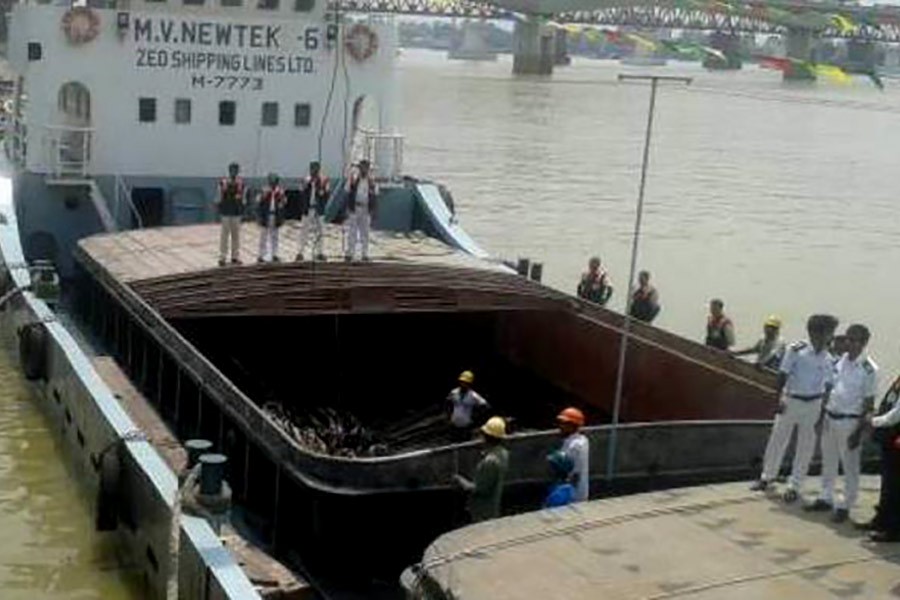After a series of debates and discussions for more than six years, Bangladesh formally opened the so-called transit facility to India in June 2016. Under this arrangement, Indian businessmen are allowed to carry goods from mainland India to the North-East region of the country through land and water ways of Bangladesh.
Two years later, it seems that there is less interest among the Indian traders on using the transit - bi-modal transhipment facility, to be exact - facility. Media reports show that only nine consignments of Indian goods have so far been carried through the route this year. The main products include steel, rice, edible oil and stone.
Earlier, it was argued by the policymakers of the two countries that the deal would be a win-win for two countries. For India, it would reduce the distance between two parts of the country and reduce trade cost. In fact, from Kolkata to Agartala through so-called chicken-neck corridor (Shiliguri corridor) it takes around 1700 km road journey. Using the Bangladesh land territory makes it only 500 km journey. For Bangladesh, it would be a booster of physical communication infrastructure and also a new business opportunity for local transport traders.
There is little scope to differ with the arguments considering the long-term benefit of the connectivity. But in reality, many obstacles are there and Indian businesses do not find it reasonably comfortable to take the advantage of the transit or transhipment facility.
Under the current arrangement, Indian goods carried by either Bangladeshi or Indian cargo ships voyage from Kolkata (capital of West Bengal state of India) to Ashuganj (Bangladesh) port through Hemnagar (India) and Mangla (Bangladesh) by rivers. From Ashuganj, Bangladeshi trucks carry the goods to Agartala (capital of Tripura state of India).
For using the river and land routes of Bangladesh, Indian traders have to pay a small transit fee of Tk 192 (US$ 2.30) per tonne. In addition, there are Tk 50 as security fee and Tk 34 as river port landing fee. The total fee comes to Tk 277 (US$ 3.38) per tonne. For longer stay in the middle of river, additional fee is applicable.
As Indian goods are not transferred to a third country but to different parts of the same country by using the territory of the second country (Bangladesh), the facility, strictly speaking, is not transit. Moreover, different types of vessels (truck-ship-truck) are used to load, unload and reload goods. So the arrangement should better be described as bi-modal transhipment facility. Under a standard transit arrangement, goods-carrying vehicles of first country (transit taking country) are allowed to pass directly through the second country (transit-giving country) to the third country (final destination).
A TRICKY ISSUE: Bangladesh government agreed to provide transit facility to India in 2009. The move triggered a debate on the issue of imposing fees or charges. To settle the matter, a core committee headed by the chairman of Bangladesh Tariff Commission (BTC) was formed. It recommended for transhipment initially, considering the limitation of the physical infrastructure. It also suggested making investment of around Tk 500 billion to develop transit infrastructure to provide the facility to India, Nepal and Bhutan in the long run. Committee suggested a set of fees and charges for providing transhipment or transit. The government has not yet formally accepted the report of the core committee, but some measurers have been taken in the light of its recommendations.
The government has apparently acknowledged the core committee's view that there is lack of physical infrastructure for introducing full-fledged transit facilities. But necessary efforts have yet to be made towards developing physical infrastructure for providing comprehensive transit to India, Nepal and Bhutan. Some works have, however, been completed in this regard, in a scattered way. The government in June, 2016 decided to provide bi-modal transhipment facility to India through Ashuganj river port.
India has been using the inland waterways of Bangladesh since 1972 to carry goods from Kolkata to Guwahati in Assam. Under the Protocol on Inland Water Transit and Trade between Bangladesh and India (PIWTT), India is to pay a lump sum charge (Tk 100 million annually as per last renewal) for keeping the river routes navigable. The protocol was last renewed in 2015 for a five-year period. The bi-modal transhipment has been introduced under this protocol.
Bangladesh Inland Water Transport Authority (BIWTA) statistics show that about 98 per cent of the Indian goods are currently carried by Bangladeshi water vessels. In FY17 Bangladeshi water vessels carried 0.26 million tonnes of goods in 3011 trips and Indian water vessels carried 22,186 tonnes of goods in 29 trips. In the nine consignment of the bi-modal transit arrangement, six were carried by Bangladeshi ships.
The Indian side is not happy with the existing transhipment facilities. The three-week time required to complete a trip, they point out, is still quite long. Secondly, handling equipment in Ashuganj river port are inadequate and unloading goods from river cargo vessels is time-consuming. Thirdly, a large portion of the road from Ashuganj to Akhura land port is narrow for which movement of trucks with Indian goods is slow.
The bi-modal transhipment arrangement is a test case for Bangladesh's ability of managing cross-border connectivity.


